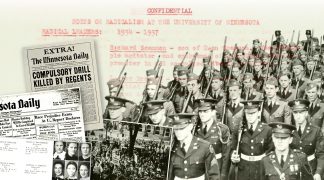The exhibit, A Campus Divided: Progressives, Anti-Communists, Racism, and Anti-Semitism at the Un
 iversity of Minnesota, 1930-1944, examines campus life at the University of Minnesota in the 1930s and early 1940s, when political battles raged between students and administrators over racial and economic equality, opposition to war, and student rights. The exhibit describes the ways in which racism, antisemitism, and segregation were part of campus life at a time when administrators routinely subjected students and faculty to surveillance and attacked progressive student activism.
iversity of Minnesota, 1930-1944, examines campus life at the University of Minnesota in the 1930s and early 1940s, when political battles raged between students and administrators over racial and economic equality, opposition to war, and student rights. The exhibit describes the ways in which racism, antisemitism, and segregation were part of campus life at a time when administrators routinely subjected students and faculty to surveillance and attacked progressive student activism. The new course uses the exhibit as a “jumping off point to explore and contextualize conflicts over historical memory in the United States,” while also looking at current issues, such as the white nationalist rally in Charlottesville on August 11 and 12.
“I think this is a stellar example of the Libraries and an academic unit collaborating to make an intellectual response to a current crisis,” said Ann Waltner, University of Minnesota history professor.
History 3000 class times and course description
The course will meet Mondays and Wednesdays during Fall Semester, from 2:30 to 3:45 p.m. and will be taught by Joe Haker, a Ph.D. candidate at the University of Minnesota and lecturer at the University of Wisconsin-Stout.
A course description is below:
“In August, at a rally against the proposed removal of a Confederate monument in Charlottesville, Virginia, anti-racist counterprotesters were brutally attacked by a white nationalist terrorist. This violence occurs at a time when bitter conflicts over public memory — whether in the form of statues, monuments, names, or symbols — have become an increasingly common part of public and campus life. At the heart of these clashes is a struggle over how to properly understand and define American history, national identity, and belonging. This course will use the ongoing University of Minnesota library exhibit “A Campus Divided” as a jumping off point to explore and contextualize conflicts over historical memory in the United States. What is at stake in battles over memory and symbols? How should contemporary views of racism, imperialism, sexism, and religious discrimination change the way we understand and commemorate the American past? Who should be commemorated, how, and why?”
About Joe Haker
Joe Haker’s dissertation focuses on political and cultural conflicts over the display of the Ten Commandments in the United States after 1945. He focuses on the displays as sites where American national identity was contested throughout the postwar era and explains the symbolic importance of the Ten Commandments to new political ideologies. His work helps to illuminate how and why current conflicts over religion, race, and national identity crystallize around monuments, symbols, and historical memory.




